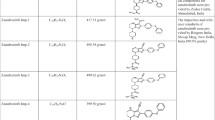Abstract
A novel liquid chromatographic method has been developed, and validated for the determination of tolterodine tartarate, for its potential three impurities in drug substances and drug products. Efficient chromatographic separation was achieved on a C8 stationary phase (150 × 4.6 mm, 3.5 μm particles) with a simple mobile phase combination delivered in an isocratic mode at a flow rate of 0.8 mL min−1 and quantitation was carried out using ultraviolet detection. Microwave assisted degradation procedure was employed for stress testing studies in addition to the conventional way of a refluxing method. The results of both studies were compared. In the developed LC method, the resolution between tolterodine and its three potential impurities was found to be greater than 2.0. Regression analysis shows an r value (correlation coefficient) greater than 0.999 for tolterodine and for its three impurities. This method was capable to detect all three impurities of tolterodine at a level below 0.0038% with respect to a test concentration of 0.5 mg mL−1 for a 10 μL injection volume. The inter- and intra-day precisions for all three impurities and for tolterodine were found to be within 1.1% RSD at its specification level. The method has shown good, consistent recoveries for tolterodine (98.9–101.6%) and for its three impurities (94.5–103.0%). The test solution was found to be stable in the diluent for 48 h. The drug was subjected to stress conditions of hydrolysis, oxidation, photolysis and thermal degradation, as prescribed by ICH. Degradation was found to occur in alkaline stress condition, while the drug was stable to water hydrolysis, acid hydrolysis, oxidative stress, photolytic and thermal stress. The assay of stressed samples was calculated against a qualified reference standard and the mass balance was found close to 99.5%. Microwave degradations were very fast and comparable to the conventional way of the refluxing method. Robustness studies were carried out and suggested that system suitability parameters were unaffected by small changes in critical factors. The validated method was successfully applied for the determination of tolterodine tartarate in drug substances and drug products.




Similar content being viewed by others
References
Nilvebrant L, Glas G, Jonsson A, Sparf B (1994) Neurourol Urodyn 13:433–435
Nilvebrant L, Stahl M, Andersson K-E (1995) Neurourol Urodyn 14:523–524
Botteghi C, Corrias T, Maschetti M, Paganelli S, Piccolo O (2002) Org Process Res Dev 6:379–383. doi:10.1021/op020014k
International Conference on Harmonization (2003) Stability testing of new drug substances and products Q1A (R2). International Conference on Harmonization, IFPMA, Geneva
Singh S, Bakshi M (2000) Pharm Tech Online 24:1–14
International Conference on Harmonization (1996) Photo stability testing of new drug substances and products Q1B. International Conference on Harmonization, IFPMA, Geneva
Bakshi M, Singh S (2002) J Pharm Biomed Anal 28:1011–1040. doi:10.1016/S0731-7085(02)00047-X
Singh S, Singh B, Bahuguna R, Wadhwa L, Saxena R (2006) J Pharm Biomed Anal 41:1037–1040. doi:10.1016/j.jpba.2006.01.030
Carstensen JT, Rhodes CT (eds) (2002) Drug stability principles and practices, 3rd edn. Marcel Dekker, New York
Ravindra Kumar Y, Ramulu G, Vevakanand VV, Vaidyanathan G, Keesari Srinivas, Kishore Kumar M, Mukkanti K, Satyanarayana Reddy M, Venkatraman S, Suryanarayana MV (2004) J Pharm Biomed Anal 35:1279–1285. doi:10.1016/j.jpba.2004.03.026
Zhang B, Zhang Z, Tian Y, Xu F (2005) J Chromatogr B 824:92–98. doi:10.1016/j.jchromb.2005.07.010
Björkman HT, Edlund P-O, Jacobsson SP (2002) Anal Chim Acta 468:263–274. doi:10.1016/S0003-2670(02)00569-X
Swart R, Koivisto P, Markides KE (1999) J Chromatogr B 736:247–253. doi:10.1016/S0378-4347(99)00462-4
Palmér L, Andersson L, Andersson T, Stenberg U (1997) J Pharm Biomed Anal 16:155–165. doi:10.1016/S0731-7085(97)00023-X
Swart R, Koivisto P, Markides KE (1998) J Chromatogr A 828:209–218. doi:10.1016/S0021-9673(98)00788-2
Acknowledgments
The authors wish to thank the management of Gensen Laboratories for supporting this work.
Author information
Authors and Affiliations
Corresponding author
Rights and permissions
About this article
Cite this article
Madhavi, A., Reddy, G.S., Suryanarayana, M.V. et al. Development and Validation of a New Analytical Method for the Determination of Related Components in Tolterodine Tartarate Using LC. Chroma 68, 399–407 (2008). https://doi.org/10.1365/s10337-008-0735-y
Received:
Revised:
Accepted:
Published:
Issue Date:
DOI: https://doi.org/10.1365/s10337-008-0735-y




